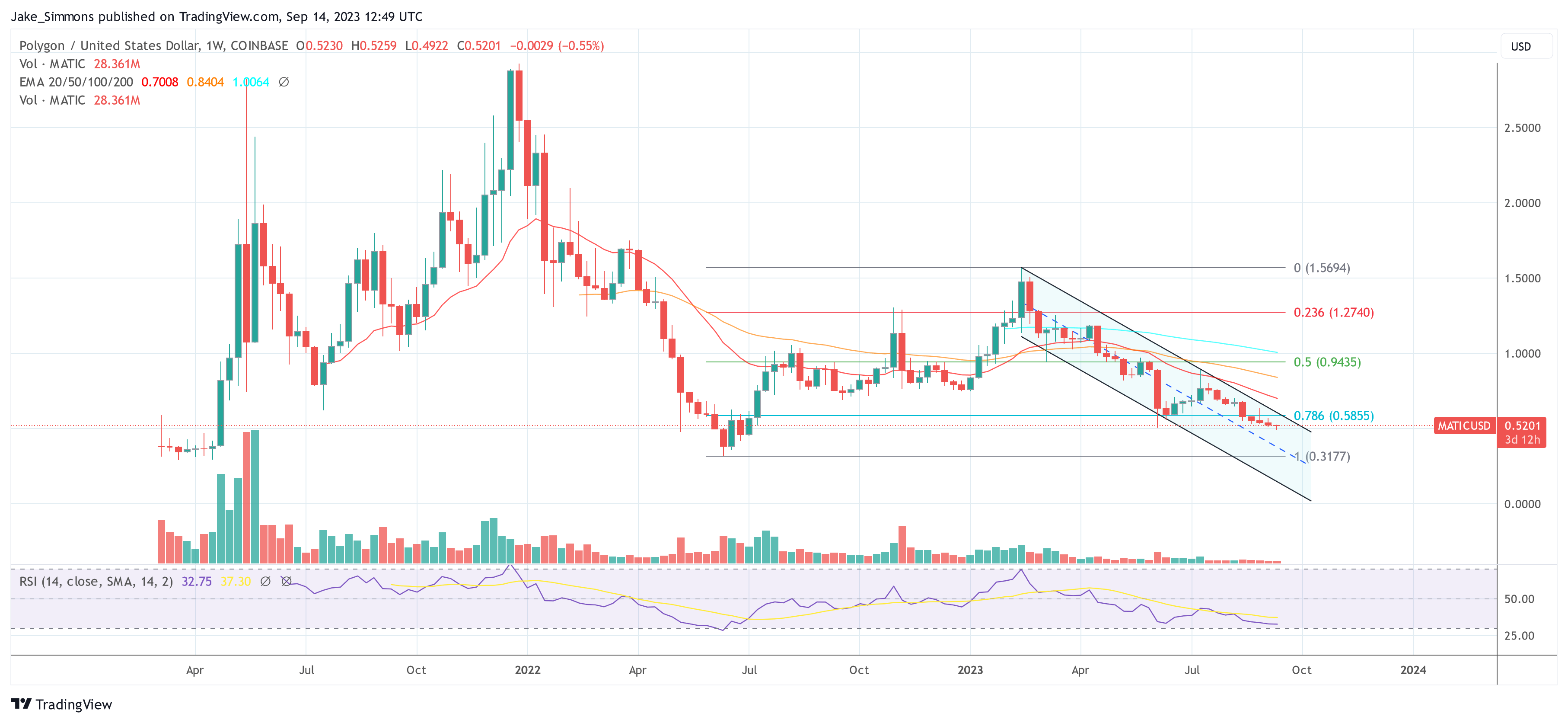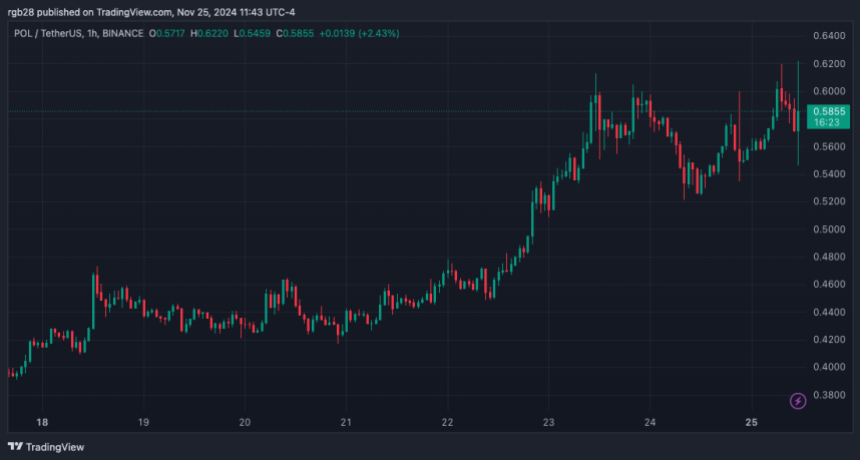Polygon Labs announced today the roll out of their ambitious Polygon 2.0 implementation. The announcement, made via a tweet, marks the release of three pivotal Polygon Improvement Proposals (PIPs) and a detailed roadmap for phase 0. “The wait is over. Polygon 2.0 implementation kicks off now,” the tweet reads, signaling the beginning of a new era for the platform.
Earlier this summer, Polygon Labs had unveiled their vision for Polygon 2.0, a roadmap that aims to scale Ethereum blockspace to create what they term as the “Value Layer of the Internet.” This transformative vision promises unlimited scalability and unified liquidity. To bring this vision to fruition, a series of upgrades to the Polygon protocol architecture are imperative. Phase 0, announced today, is the first step in this direction.
Phase 0 focuses on four main upgrades to the protocol:
Polygon Labs has indicated that if the community endorses these proposals, the implementation could begin as early as the fourth quarter of this year. It’s noteworthy that the changes detailed in the first three PIPs are designed to be seamless, ensuring no disruptions for end-users at this stage.
An official blog post, also released today, provides deeper insights into the transformative journey of Polygon 2.0, which was first introduced to the public in June. This set of proposed enhancements seeks to revolutionize nearly every facet of the Polygon ecosystem. The three PIPs released today offer a comprehensive blueprint for phase 0. Their goal is to construct a network of interconnected zero-knowledge-powered L2 chains, effectively scaling Ethereum to the vast expanse of the Internet.
Central to these PIPs is the transition process, the specifications for the revamped token of the Polygon 2.0 architecture, and crucial updates to the Polygon PoS native token.
PIP-18, titled “Polygon 2.0 Phase 0,” offers a comprehensive overview of the initial phase, detailing the upgrades that will be further elaborated upon in subsequent PIPs. The milestones of phase 0 are crafted with the user in mind, ensuring minimal disruptions for those already operating on Polygon PoS and Polygon zkEVM chains.
Meanwhile, PIP-17 delves into the intricacies of the POL token, outlining the associated contracts that will oversee its emission and migration. The POL token is not just a new name; it represents a next-generation token designed to accommodate an ecosystem of ZK-based Layer 2 chains, enabling staking, community ownership, and governance.
Lastly, PIP-19 focuses on the transition of the native gas token on Polygon POS from MATIC to POL. This transition is designed to ensure maximum compatibility with existing systems, with the native token’s properties remaining unchanged.
The MATIC price currently remains in a downtrend channel that saw its beginning in mid-February this year. MATIC hit its yearly high of $1.56 on February 13 and has fallen 68% since then. However, a look at the 1-week chart shows that there is hope for MATIC bulls.
At the time of writing, MATIC was trading at 0.5184. All it would take to breathe new life into the MATIC price is a move above $0.5855. This price level marks the 78.6% Fibonacci retracement level, in addition, a move above this price would signify a breakout from the downtrend channel. The bulls could regain the upper hand and target the 20-week EMA at $0.7007.
Another key resistance level is at $0.7698, where the 200-day EMA is located. A rise to this price level would already represent a 45% rally. As then, the 50% Fibonacci retracement level at $0.9435 could be targeted by the bulls. Major selling pressure can also be expected at $1.27 (23.6% Fibonacci retracement level) before the yearly high would be within reach.
Polygon 2.0 clearly has the potential to awaken the bulls from their slumber. However, the $0.5855 price level is the critical key. If MATIC fails at this price level, a sweep of 65-week low at $0.3177 could loom.

Earlier this summer, Polygon Labs had unveiled their vision for Polygon 2.0, a roadmap that aims to scale Ethereum blockspace to create what they term as the “Value Layer of the Internet.” This transformative vision promises unlimited scalability and unified liquidity. To bring this vision to fruition, a series of upgrades to the Polygon protocol architecture are imperative. Phase 0, announced today, is the first step in this direction.
Phase 0 focuses on four main upgrades to the protocol:
- The transition from MATIC to POL.
- Establishing POL as the native (gas) token for PoS.
- Designating POL as the staking token for PoS.
- The introduction of the Staking Layer, a feature that will empower validators to secure a diverse range of chains within the evolving Polygon 2.0 ecosystem.
What Phase 0 Of Polygon 2.0 Brings
Polygon Labs has indicated that if the community endorses these proposals, the implementation could begin as early as the fourth quarter of this year. It’s noteworthy that the changes detailed in the first three PIPs are designed to be seamless, ensuring no disruptions for end-users at this stage.
An official blog post, also released today, provides deeper insights into the transformative journey of Polygon 2.0, which was first introduced to the public in June. This set of proposed enhancements seeks to revolutionize nearly every facet of the Polygon ecosystem. The three PIPs released today offer a comprehensive blueprint for phase 0. Their goal is to construct a network of interconnected zero-knowledge-powered L2 chains, effectively scaling Ethereum to the vast expanse of the Internet.
Central to these PIPs is the transition process, the specifications for the revamped token of the Polygon 2.0 architecture, and crucial updates to the Polygon PoS native token.
PIP-18, titled “Polygon 2.0 Phase 0,” offers a comprehensive overview of the initial phase, detailing the upgrades that will be further elaborated upon in subsequent PIPs. The milestones of phase 0 are crafted with the user in mind, ensuring minimal disruptions for those already operating on Polygon PoS and Polygon zkEVM chains.
Meanwhile, PIP-17 delves into the intricacies of the POL token, outlining the associated contracts that will oversee its emission and migration. The POL token is not just a new name; it represents a next-generation token designed to accommodate an ecosystem of ZK-based Layer 2 chains, enabling staking, community ownership, and governance.
Lastly, PIP-19 focuses on the transition of the native gas token on Polygon POS from MATIC to POL. This transition is designed to ensure maximum compatibility with existing systems, with the native token’s properties remaining unchanged.
MATIC Price Analysis
The MATIC price currently remains in a downtrend channel that saw its beginning in mid-February this year. MATIC hit its yearly high of $1.56 on February 13 and has fallen 68% since then. However, a look at the 1-week chart shows that there is hope for MATIC bulls.
At the time of writing, MATIC was trading at 0.5184. All it would take to breathe new life into the MATIC price is a move above $0.5855. This price level marks the 78.6% Fibonacci retracement level, in addition, a move above this price would signify a breakout from the downtrend channel. The bulls could regain the upper hand and target the 20-week EMA at $0.7007.
Another key resistance level is at $0.7698, where the 200-day EMA is located. A rise to this price level would already represent a 45% rally. As then, the 50% Fibonacci retracement level at $0.9435 could be targeted by the bulls. Major selling pressure can also be expected at $1.27 (23.6% Fibonacci retracement level) before the yearly high would be within reach.
Polygon 2.0 clearly has the potential to awaken the bulls from their slumber. However, the $0.5855 price level is the critical key. If MATIC fails at this price level, a sweep of 65-week low at $0.3177 could loom.




